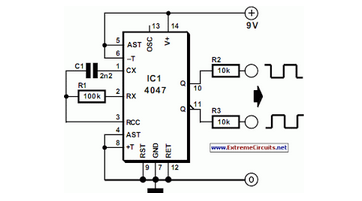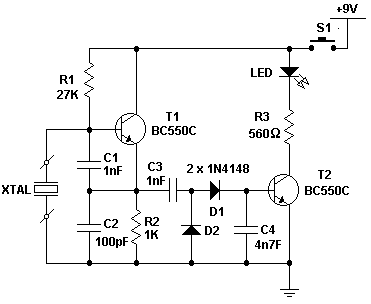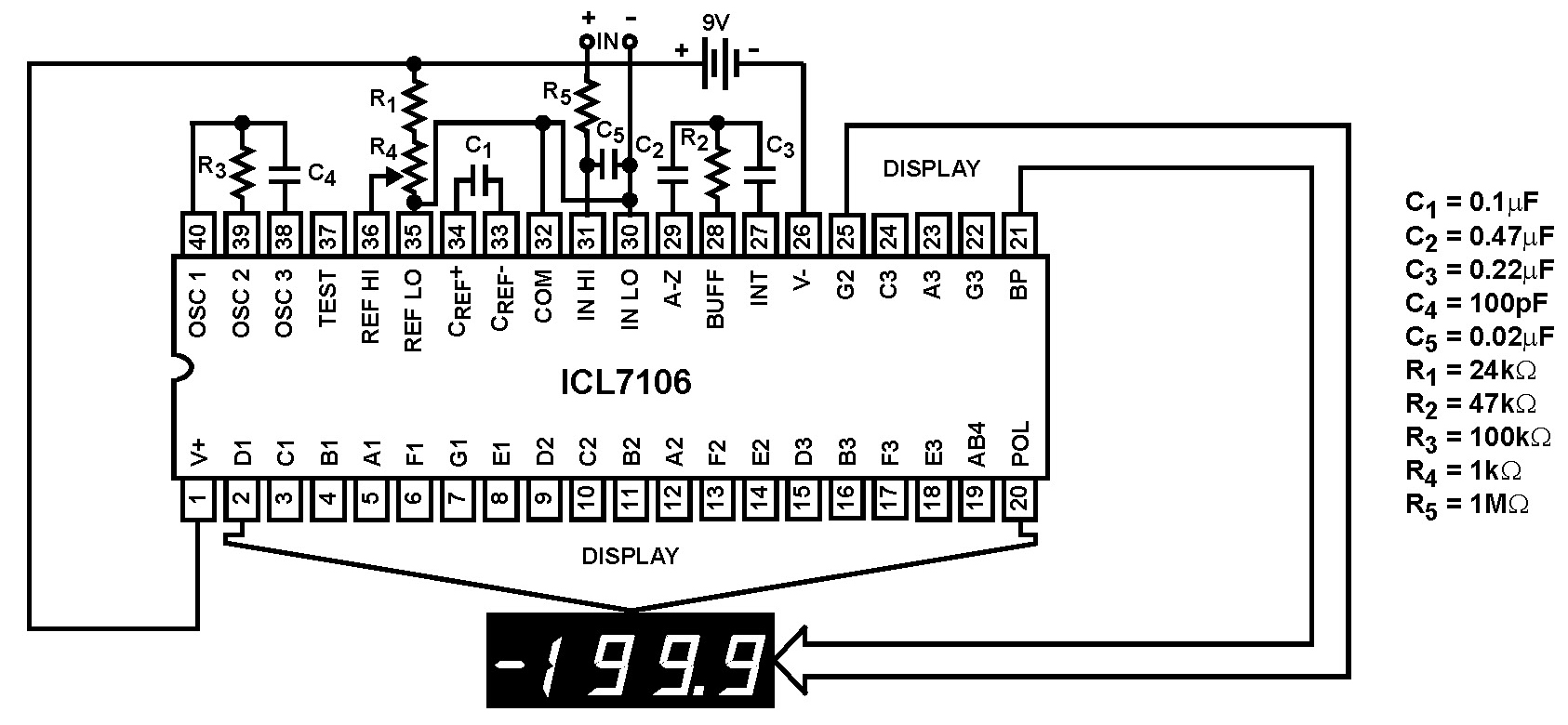
Liquid-Crystal Display (LCD) Tester

A segment can be tested by applying an alternating voltage of a few volts across it. It is important to note that applying a direct voltage can cause irreversible damage to the display, as the resulting current will remove the tracks. The alternating voltage should not contain any direct voltage component. While an alternating current can remove part of the tracks when the current flows in one direction, it can restore them when it flows in the opposite direction. The tester described consists of a square-wave generator that produces a perfectly symmetrical alternating voltage without any direct current component. Most logic oscillators are unable to generate a true square wave signal; instead, they produce rectangular waveforms with a duty cycle around 50%. The 4047 integrated circuit used in the tester features a binary scaler at its output that ensures symmetry. The oscillator operates at a frequency of approximately 1 kHz and can be powered by a 3 to 9 V source. Typically, this will be a battery, although using a variable power supply can provide benefits. It allows observation of the voltage at which the display functions satisfactorily and demonstrates the clear relationship between voltage level and the readability angle of the display. The tester draws a current not exceeding 1 mA. The test voltage must always be connected between the common terminal (the back plane) and one of the segments. If the back plane terminal is unknown, one probe of the tester should be connected to a segment while the other is connected successively to all other terminals until the segment becomes visible. It is important to note that some LCDs may have more than one back plane. Therefore, if a segment does not become visible, it is advisable to check for the presence of a second back plane terminal.
The testing circuit described utilizes a square-wave generator, specifically the 4047 integrated circuit, which is designed to produce a symmetrical alternating voltage necessary for testing liquid crystal displays (LCDs). The 4047 operates in astable mode, generating a square wave output with a frequency of approximately 1 kHz. This frequency is suitable for ensuring that the voltage applied to the LCD segments is effective without causing damage. The output from the 4047 goes through a binary scaler, which maintains the symmetry of the waveform, ensuring that there is no direct current component present in the signal.
The power supply for the circuit can range from 3 to 9 volts, typically provided by a battery for portability. However, using a variable power supply allows for fine-tuning of the voltage to determine the optimal operating conditions for the LCD under test. The current drawn by the tester is limited to a maximum of 1 mA, which is safe for the delicate components of the display.
When conducting the test, it is crucial to connect the test voltage between the common terminal (the back plane) and one of the display segments. If the back plane is not readily identifiable, a systematic approach should be taken by connecting one probe to a segment and the other probe to each terminal in succession until the segment is activated and becomes visible. This methodical testing is essential, especially in cases where the LCD may have multiple back plane connections. If a segment does not respond, further investigation into the display's configuration is warranted to locate any additional back plane terminals that may exist. This testing procedure ensures that the integrity of the LCD is maintained while effectively diagnosing any issues with the segments.A segment may be tested by applying an alternating voltage of a few volts across it. Note that the application of a direct voltage will damage the display irreversibly: the resulting current will remove the tracks. The alternating voltage should contain not even a tiny direct voltage component. An alternating current also removes part of the tracks when the current flows in one direction, but restores it when the current flows in the opposite direction. The tester described here consists of a square-wave generator that produces an absolutely symmetrical alternating voltage without any d. c. component. Most logic oscillators are incapable of producing a squarewave signal: they generate rectangular waveforms whose duty cycle hovers around the 50%.
The 4047 used in the tester has a binary scaler at its output that guarantees symmetry. The oscillator frequency is about 1 kHz. It may be powered from a 3 9 V source. Normally, this will be a battery, but a variable power supply has advantages. It shows at which voltage the display works satisfactorily and also that there is a clear relationship between the level of the voltage and the angle at which the display is clearly legible. The tester draws a current not exceeding 1 mA. The test voltage must at all times be connected between the common terminal, that is, the back plane, and one of the segments.
If it is not known which of the terminals is the back plane, connect one probe of the tester to a segment and the other successively to all the other terminals until the segment becomes visible. Note, however, that there are LCDs with more than one back plane. Therefore, if a segment does not become visible, investigate whether the display has a second back plane terminal.
🔗 External reference
The testing circuit described utilizes a square-wave generator, specifically the 4047 integrated circuit, which is designed to produce a symmetrical alternating voltage necessary for testing liquid crystal displays (LCDs). The 4047 operates in astable mode, generating a square wave output with a frequency of approximately 1 kHz. This frequency is suitable for ensuring that the voltage applied to the LCD segments is effective without causing damage. The output from the 4047 goes through a binary scaler, which maintains the symmetry of the waveform, ensuring that there is no direct current component present in the signal.
The power supply for the circuit can range from 3 to 9 volts, typically provided by a battery for portability. However, using a variable power supply allows for fine-tuning of the voltage to determine the optimal operating conditions for the LCD under test. The current drawn by the tester is limited to a maximum of 1 mA, which is safe for the delicate components of the display.
When conducting the test, it is crucial to connect the test voltage between the common terminal (the back plane) and one of the display segments. If the back plane is not readily identifiable, a systematic approach should be taken by connecting one probe to a segment and the other probe to each terminal in succession until the segment is activated and becomes visible. This methodical testing is essential, especially in cases where the LCD may have multiple back plane connections. If a segment does not respond, further investigation into the display's configuration is warranted to locate any additional back plane terminals that may exist. This testing procedure ensures that the integrity of the LCD is maintained while effectively diagnosing any issues with the segments.A segment may be tested by applying an alternating voltage of a few volts across it. Note that the application of a direct voltage will damage the display irreversibly: the resulting current will remove the tracks. The alternating voltage should contain not even a tiny direct voltage component. An alternating current also removes part of the tracks when the current flows in one direction, but restores it when the current flows in the opposite direction. The tester described here consists of a square-wave generator that produces an absolutely symmetrical alternating voltage without any d. c. component. Most logic oscillators are incapable of producing a squarewave signal: they generate rectangular waveforms whose duty cycle hovers around the 50%.
The 4047 used in the tester has a binary scaler at its output that guarantees symmetry. The oscillator frequency is about 1 kHz. It may be powered from a 3 9 V source. Normally, this will be a battery, but a variable power supply has advantages. It shows at which voltage the display works satisfactorily and also that there is a clear relationship between the level of the voltage and the angle at which the display is clearly legible. The tester draws a current not exceeding 1 mA. The test voltage must at all times be connected between the common terminal, that is, the back plane, and one of the segments.
If it is not known which of the terminals is the back plane, connect one probe of the tester to a segment and the other successively to all the other terminals until the segment becomes visible. Note, however, that there are LCDs with more than one back plane. Therefore, if a segment does not become visible, investigate whether the display has a second back plane terminal.
🔗 External reference





